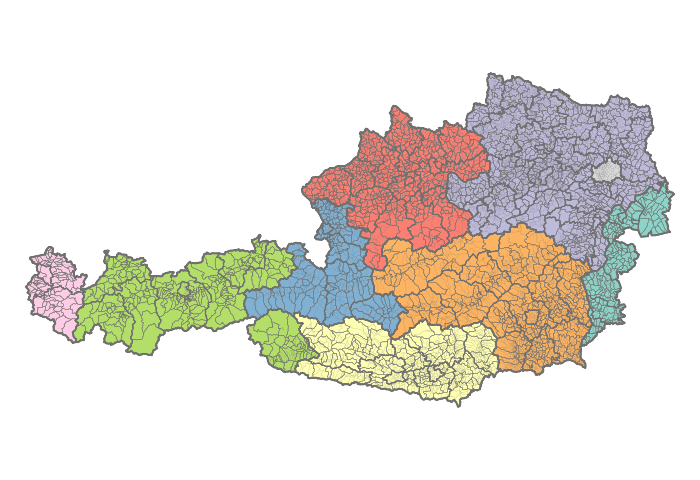Austria has 9 federal states, each of which is responsible for legislative and executive tasks and has its own constitutions. The provinces are Upper Austria, Lower Austria, Vienna, Burgenland, Styria, Carinthia, Salzburg, Tyrol, Vorarlberg, Salzburg and Austria.
Administrative structure in Austria
Austria is a federal state consisting of nine federal states. The state has a typically republican-democratic constitution with a (moderate) federalist structure. The state as a whole (under state law: upper state, colloquially: "federation") is responsible for essential tasks such as federal legislation, foreign and defence policy or ordinary jurisdiction. In addition, the 9 federal states and - as the smallest organisational unit of the state - the municipalities act as territorial authorities. The 5-digit municipality code (GKZ) (e.g. Vienna 90001) serves to uniquely identify the administrative units. Its allocation is the responsibility of the Statistics Austria authority.


The federal territory is subdivided into 94 political districts, namely 15 statutory cities and 79 rural districts. The political districts represent the lowest administrative unit of the state administration.
(see http://statistik.at/web_de/klassifikationen/regionale_gliederungen/politische_bezirke/index.html)
The municipality in Austria is regarded as a regional authority with the right to self-administration and at the same time an administrative district. The structure of the Austrian municipalities is rather small. Only a few municipalities throughout Austria have more than a few thousand inhabitants, the small municipalities of the rural area dominate the landscape strikingly.
The municipalities - as the smallest organizational unit of the state - have no legislative power. However, they can issue general regulations (ordinances) and assume many state administrative tasks. The municipalities are self-governing bodies. This means that they have a clearly defined and "protected" area of activity of their own, as defined by the Federal Constitution, in which the tasks are carried out without instructions. The freedom to issue directives is not impaired by state supervision of the self-governing institution.
The Austrian Association of Municipalities and the Austrian Association of Towns and Cities represent the interests of the municipalities and cities and act as contact persons for the government at federal and provincial level. Membership is voluntary in each case, but practically all municipalities with more than 10,000 inhabitants are members of the Association of Towns and Municipalities and 2,085 of the total of 2,095 municipalities are part of the Association of Municipalities. There are double memberships.
Literature
Association of Austrian Municipalities: Structure of Municipalities (online at: https://gemeindebund.at/struktur-der-gemeinden/)
Bundesanstalt Statistik Österreich: Statistik Austria (online at: http://statistik.at)
Federal Ministry for Digitization and Business Location: HELP.gv.at (online at: https://www.help.gv.at/)
Austrian Association of Towns and Cities (online at: https://www.staedtebund.gv.at/)
